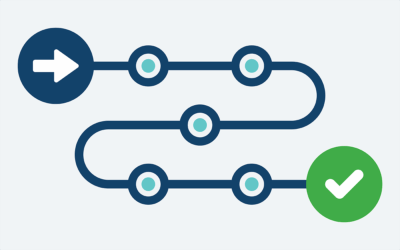Almost every day here at The Brooks Group, we get calls from sales leaders who notice their sellers lack a certain … let’s call it “get up and go.”
Instead of selling proactively—always on the move to find new prospects and uncover new business—they tend to hang back and wait for the orders to come in.
These sales leaders are frustrated by what they see as sellers taking the easy route. They want their sales professionals to show more initiative.
In my experience, when sales leaders say their sellers aren’t being proactive, it’s because the leaders aren’t making it a priority, focusing on the right behaviors, working with them to build plans, or holding salespeople accountable.
How can you motivate, train, and coach your teams to be more proactive?
It’s time to turn the page on the pandemic and get your head back in the game. Here’s my advice to put your sellers in a position to win.
Focus on Sales Metrics That Matter
Many sales leaders aren’t managing proactive behaviors; they’re only managing the results. For example, when the Ohio State Buckeyes play, they don’t just show up and expect to win. They watch game film, practice their plays, and perfect their execution.
The score at the end of the game is a lagging indicator of all their preparation. Lagging indicators relate to outcomes, output, and impact. They’re historical in nature, telling you how your sellers performed in the past.
Proactive leaders focus on leading indicators—forward-looking measures that help you gauge eventual outcomes. You can’t just look at your team’s win/loss rate and expect them to sell differently. Proactive sales leaders build strategic plans, focus on the right activities, and hold their sellers accountable for missed targets. These are leading indicators for sales success.
What Is Proactive Selling?
If your sales team doesn’t think something is a priority for you, they won’t focus on it. As a leader, it’s vital to adapt to the current reality and shift your teams from a reactive to a proactive selling approach.
What does it mean to have a team of proactive sellers?
Maintain Customer Relationships
Proactive sellers maintain regular contact with high-value accounts to keep your company on the radar, add value as a strategic resource, and get ahead of issues before competitors spot them.
Identify New Sales Opportunities
Proactive sellers conduct customer research to uncover upsell and cross-sell opportunities and reveal new needs and priorities.
Increase Sales Pipeline and Revenue
Proactive sellers prospect continuously to build a healthy sales pipeline, forecast accurately, and generate higher revenue.
Gain Competitive Advantage
Proactive sellers approach potential customers before your competitors do and position themselves as trusted advisors.
Mitigate Risk
Proactive sellers have a diverse customer base, which reduces their dependence on a small number of existing accounts.
8 Essential Proactive Selling Skills
Proactive sales techniques are not just beneficial but necessary in the current market. Sales leaders must adopt a more engaged, forward-thinking approach to equip their teams in today’s competitive market.
These are the essential selling skills you need to train your team on and reinforce continually.
1. Prospecting
This is the foundation of proactive selling. It involves actively seeking out new potential customers rather than waiting for them to come to you.
2. Active Listening
This skill allows salespeople to truly understand customer needs and tailor their approach accordingly.
3. Consultative Selling
A consultative selling approach positions the sales professional as a strategic resource who provides valuable insights, not just products or services.
4. Strategic Planning
This involves taking a long-term, goal-oriented approach to sales, rather than focusing solely on short-term wins.
5. Relationship Building
This skill is about creating and maintaining long-term, mutually beneficial relationships with customers.
6. Problem-Solving
Proactive sellers anticipate and address customer challenges, often before the customers themselves are fully aware of them.
7. Storytelling and Communication
The ability to craft and deliver compelling narratives can make complex solutions more accessible and appealing to customers.
8. Persistence and Resilience
Proactive selling often involves facing rejection and setbacks, making these qualities essential for long-term success.
These eight skills form the core of proactive selling. When developed and applied effectively, they enable sales professionals to create opportunities, build strong customer relationships, and drive business growth.
3 Steps for Sales Leaders to Promote Proactive Selling
Many businesses have experienced a huge realignment in market dynamics. Here are three steps sales leaders can take to reignite proactivity in their sales teams.
Step 1: Define Goals and Expectations
Communicate Market Changes
Sales teams need to understand that buyers have changed. The days of orders arriving without effort are over. Reinforce that sustainable success requires prospecting and building relationships again.
Set New Metrics
Sales leaders should focus on activity-based sales metrics (e.g., outreach attempts, new meetings set) rather than relying on passive order intake. Clear key performance indicators (KPIs) for prospecting, relationship building, and pipeline growth can incentivize the team to become more active.
Step 2: Build Consultative Selling Skills
Training Programs
Reintroduce or enhance sales training in consultative selling. Emphasize the importance of identifying customer pain points and positioning the product as a solution, rather than simply fulfilling demand.
Role-Playing Exercises
Practice sales scenarios where sellers need to engage with potential buyers, uncover needs, and provide consultative advice. This helps salespeople rebuild confidence in initiating conversations.
Hybrid Selling Techniques
The pandemic has permanently changed how customers buy, with many now preferring digital interactions. Sales teams need to master virtual selling techniques—including video outreach, virtual demos, and follow-ups—to engage buyers who might still prefer remote interactions.
Coaching and Accountability
Refocus your sales coaching from problem-solving after the fact to strategic planning before challenges arise. Create a can-do atmosphere and help sellers craft new outreach strategies.
Step 3: Leverage Technology for Sales Efficiency
CRM Optimization
Integrate your sales process into your CRM and ensure your team is using the CRM for tracking outreach and nurturing activities. Automated reminders can prompt sellers to follow up with leads and keep opportunities from slipping through the cracks.
Data-Driven Insights
Use data analytics to identify market gaps and high-potential leads. This can help sellers focus their energy on promising prospects rather than relying on inbound requests.
Adapt to the New Normal
Sales leaders, it’s time to adjust to reality. By fostering a motivated mindset, giving your teams the right tools and training, and holding your sellers accountable, you can avoid the trap of reactive selling and ensure long-term growth.
Find out how sales training from The Brooks Group can help your sales team develop proactive consultative selling skills.




